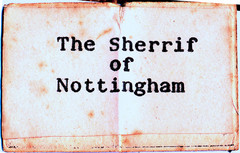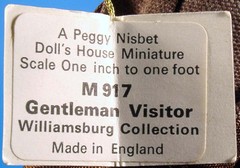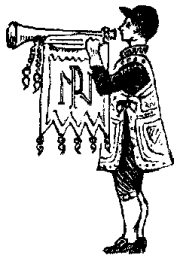Book Tags (Labels)
Before looking at the tag on your doll, you first have to find it! Tags are usually suspended from the doll's left wrist, but what can you do if it isn't there?
Surprisingly, we have found "lost" tags tucked up inside the clothes, or tied around the doll's knee or thigh, under the skirts and petticoats, so don't despair if it is not immediately obvious - Check the doll's clothing over carefully, as it might be hidden inside! (Some collectors used to remove the tags and hide them in the clothing, before displaying the doll)
The (book) tag is the first and most obvious clue to a Nisbet Doll's identity - certainly, for the Historical, Portrait, and most of the other ranges, the labels can sometimes tell you more than you may think.
Also, you may be forgiven for thinking that tags are either red or black, rectangular, and folded like a book. Think again - there's a bit more to them than you might guess!
Tower Walk tags
Tower walk tags are, as far as we are aware, the earliest tags to be found on a Nisbet doll. Square in shape, and printed on white card, (and sometimes with a coloured border), the reverse was often hand written by Peggy Nisbet herself, in her beautifully neat and very distinctive handwriting, usually with a fountain pen. These tags were suspended from a corner, to present a diamond or lozenge shape
Black (or Red) Book Tags
The red book tag tells us the doll was made at Peggy's Leitholm cottage, (in the Scottish Borders, near Coldstream). Dolls made here were exclusively Scottish in subject, (such as Bonnie Prince Charlie, and Mary, Queen of Scots). As with the black tags, the plain back indicates that the doll is of a similar early vintage
Happy Doll "Heart" Tags
Gold Book Tags
Inside the Tag
It is on the inside of the tag that the really important information about the doll can be found - and it's not all necessarily there in black and white!
Handwritten Tags
Handwritten tags generally indicate that the doll was a part of a small quantity production run (as the Tower Walk Lady Jane Grey, above left), or that the doll was a prototype or sample (the Lord Mayor prototype, above right).
The Lady Jane Grey label on the left was written by Peggy Nisbet - her clear and distinctive writing is unmistakable.
Typed Inner Labels
Typed labels stuck inside the tags were used for production runs of between 25 to 250. We were told that it was a question of economics - the cost of a print run for much less than 250 tags was so high that it was more economical to type them out by hand.
The "Sherrif of Nottingham" tag (left) is from a very early doll, and the type face is consistent with that of an older typewriter dating from the 1930's or earlier.
The "Margaret of Anjou" tag is from a slightly later doll - (the more artistic font suggests an early 1960's IBM Selectric "golf ball" typwriter was used to produce this label - Despite its technological advances, the spelling error shows that it didn't have a spellchecker built-in, as modern PCs do!)
Printed Inner Labels
Printed inner labels generally indicate a production run in excess of 250 dolls.
However, the label on the left confirms a story we heard, which said that a sophisticated "John Bull" printing set was sometimes used for small to medium run label production, (quantities of between 50 to 300). The giveaway is the filled in centres of the letters e and a, and the faint smudged marks between the date letters, all typical of lettering produced by rubber stamps.
("John Bull" printing sets were a popular children's toy in the '40s, '50s and '60s. They consisted of alpha/numeric rubber typeface blocks, (covering the alphabet and some of the more common punctuation marks, plus the numbers 0 to 9, and grooved wooden handles, to hold them. Pressed onto an ink pad, and then onto paper, one of the more professional sets would give results very close to a printed label).
The label on the right is a printed version, and is typical of most inner labels seen from the '70s onwards, when much larger production runs were commonplace. The text is crisp and clean, and much darker than the "John Bull" typeface
Summary :
The tag can help not only to identify the doll, but also its age, and whether it was from a smaller or larger production run - and this, too, may give valuable pointers to the doll's age, as earlier dolls were generally, (though not always), made in smaller batches
One word of caution -
Just because the tag is on the doll, it doesn't mean that it actually started its life with it - There may always exist the possibility that the first owner removed the tags from their dolls to display them, and mixed the tags up later on, when replacing them.





















